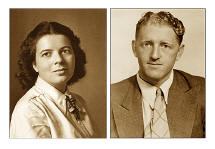

Hilda Bernstein ProfileObituaries15th April 1915 to 8th September 2006Hilda Bernstein was born in London, one of three daughters of Simeon and Dora Schwarz. She left an indelible mark on the struggle for racial equality in South Africa and is especially remembered for her work with women, long before this became fashionable. Her father was a Bolshevik who became the Russian Trade Attache in London in 1919, but left the family when he was recalled to Russia when Hilda was 10. Hilda left school to work, before emigrating to South Africa in 1933 aged 18 after receiving the news of her fathers death, having never returned from the Soviet Union.
She met Lionel (Rusty) Bernstein through shared political involvement, and they were married in 1941. During the 1950s she started to organise with women. In 1956 she was one of the founders of the first multi-racial women’s organisation, the Federation of South African Women, which was to be a stepping stone for some of its members to later become outstanding leaders of the ANC. She played a key role in organising the historic Women’s March to Pretoria. She also helped to found the South African Peace Council and was its national secretary until being banned. As with so many others, Hilda met with a succession of government attempts to stop her
political activity, starting in 1946 with a conviction for assisting an illegal strike of black mineworkers. In
1953 she was banned from 26 organisations and from attending any meetings; in 1958 her renewed banning orders
included a ban on writing or publishing (she was a regular writer for periodicals in South Africa, other
African countries, and Europe). In 1960 she was detained during the State of Emergency following the
Sharpeville shootings. She continued political work clandestinely.
In 1963 her husband Rusty was arrested at Rivonia and charged together with Nelson Mandela and others. He was acquitted, rearrested, recharged, then released on bail. Soon after his release, Hilda fled from their home as the police came to arrest her. She and Rusty crossed the frontier on foot to Botswana, ultimately arriving in London. The story of the Rivonia arrests, trial and their escape was dramatically told in her book “The World That was Ours”. In exile, Hilda continued to be active in the ANC, including the Women's section, and also the Anti-Apartheid Movement and the British peace movement. Her public speaking and writing skills were used extensively for all these causes throughout Europe, the USA and Canada. In middle age, and with four children to see to, Hilda also forged a new life as an artist and writer. She had many one-person shows of her etchings, drawings and paintings in London and elsewhere, and exhibited extensively in group shows of print-makers and women artists in the UK, USA, Europe and African countries. Her work has been hung several times in the Royal Academy and is in both public and private collections throughout the world. It has also been used on book jackets and illustrations, on posters as greetings cards for the Anti-Apartheid Movement. Both Hilda and Rusty felt they were part of the luckiest generation, to have lived to see
the end of apartheid and victory for the ANC, a cause they had both dedicated their lives to. They both came
back
In 2004, aged 89, Hilda was very proud to receive the Luthuli Silver Award for "contribution to the attainment of gender equality and a free and democratic society" in South Africa. At the time of her death at 91 she was living in Cape Town. Hilda brought unbounded energy, creativity and tenacity to whatever she undertook. More specially, she combined these with a fierce integrity and commitment to humanity. Along with her legacy as an artist, writer and political activist, she leaves four children (Toni, Patrick, Frances and Keith), seven grand children and four great grand children. Hilda Bernstein’s publications include:The World That Was Ours (in English, Russian, German, and Dutch) "Meeting The
Leaders" - Hilda Bernstein, 1990 |